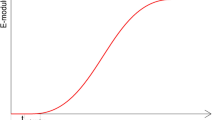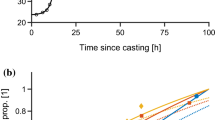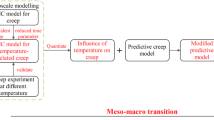Abstract
Different factors related to construction site conditions must be accounted for when designing concrete massive structures in order to accurately predict the cracking risks at early-age. Detailed descriptions of the thermal and mechanical boundary conditions as well as analyses accounting for the coupling between damage and creep may lead to computationally expensive simulations campaign. On the other hand, simplified modelling strategies have been extensively used but may not capture accurately key aspects of such analysis. Based on a previous chemo-thermal analysis by Honorio et al. (Eng Struct 80:173–188, 2014), the present study focuses on the mechanical behaviour of a specific structure by making use of a coupled thermo-chemo-creep-damage model. Simplified modelling strategies to treat the external restraints and some thermal boundary conditions are compared to more realistic ones. The risks of cracking are assessed by means of a cracking index (CI) and a damage model. Restraint conditions in which the ground is not represented leads to cracking risks in different zones if compared to the case with the ground. It is shown that, the ambient temperature affects directly the tensile stresses reached and the oscillation of the temperature within a day may play a non-negligible role. The effect of damage and its coupling with creep are analysed, and a strong influence of the corresponding coupling parameter on the cracking initiation and propagation is observed.













Similar content being viewed by others
References
Honorio T, Bary B, Benboudjema F (2014) Evaluation of the contribution of boundary and initial conditions in the chemo-thermal analysis of a massive concrete structure. Eng Struct 80:173–188. doi:10.1016/j.engstruct.2014.08.050
Azenha M (2009) Numerical simulation of the structural behaviour of concrete since its early ages. PhD Thesis, Universidade do Porto
Briffaut M, Benboudjema F, Torrenti J-M, Nahas G (2012) Effects of early-age thermal behaviour on damage risks in massive concrete structures. Eur J Environ Civ Eng 16:589–605. doi:10.1080/19648189.2012.668016
Briffaut M, Benboudjema F, Torrenti JM, Nahas G (2011) Numerical analysis of the thermal active restrained shrinkage ring test to study the early age behavior of massive concrete structures. Eng Struct 33:1390–1401
Ishida T, Luan Y, Sagawa T, Nawa T (2011) Modeling of early age behavior of blast furnace slag concrete based on micro-physical properties. Cem Concr Res 41:1357–1367. doi:10.1016/j.cemconres.2011.06.005
Potgieter IC, Gamble WL (1983) Response of Highway Bridges to Nonlinear Temperature Distributions. Technical Report, Civil Engineering Studies SRS-505, University of Illinois Engineering Experiment Station. College of Engineering. University of Illinois at Urbana-Champaign. Available in https://www.ideals.illinois.edu/handle/2142/14113
Toutlemonde F, Torrenti J-M (eds) (2012) Crack control of mass concrete and related issues concerning early-age of concrete structures. In: RILEM-JCI International workshop on crack control of mass concrete and related issues concerning early-age of concrete structures - CONCRACK 3 - Control of cracking in concrete structures 3, p 85
Gaspar A, Lopez-Caballero F, Modaressi-Farahmand-Razavi A, Gomes-Correia A (2014) Methodology for a probabilistic analysis of an RCC gravity dam construction. Modelling of temperature, hydration degree and ageing degree fields. Eng Struct 65:99–110. doi:10.1016/j.engstruct.2014.02.002
Ulm F-J, Coussy O (2001) What is a “massive” concrete structure at early ages? Some dimensional arguments. J Eng Mech 127:512–522
Ulm F-J, Coussy O (1998) Couplings in early-age concrete: From material modeling to structural design. Int J Solids Struct 35:4295–4311. doi:10.1016/S0020-7683(97)00317-X
De Schutter G (2002) Finite element simulation of thermal cracking in massive hardening concrete elements using degree of hydration based material laws. Comput Struct 80:2035–2042. doi:10.1016/S0045-7949(02)00270-5
De Schutter G (2002) Fundamental study of early age concrete behaviour as a basis for durable concrete structures. Mater Struct 35:15–21. doi:10.1007/BF02482085
Fairbairn EMR, Silvoso MM, Toledo Filho RD et al (2004) Optimization of mass concrete construction using genetic algorithms. Comput Struct 82:281–299. doi:10.1016/j.compstruc.2003.08.008
Faria R, Azenha M, Figueiras JA (2006) Modelling of concrete at early ages: application to an externally restrained slab. Cem Concr Compos 28:572–585. doi:10.1016/j.cemconcomp.2006.02.012
Buffo-Lacarrière L, Sellier A, Escadeillas G, Turatsinze A (2007) Multiphasic finite element modeling of concrete hydration. Cem Concr Res 37:131–138
Buffo-Lacarrière L, Sellier A, Kolani B (2014) Application of thermo-hydro-chemo-mechanical model for early age behaviour of concrete to experimental massive reinforced structures with strain–restraining system. Eur J Environ Civ Eng 18:814–827. doi:10.1080/19648189.2014.896754
Van Breugel K, Koenders EAB (2001) Solar radiation. Luleå University of Technology, Lulea
Cope JL, Cannon RW, Abdun-Nur EA, et al (2002) ACI 207.2R–95 Effect of restraint, volume change, and reinforcement on cracking of mass concrete. Technical Report, Reported by ACI Committee 207. ACI Man Concr Pract
Benboudjema F, Torrenti JM (2008) Early-age behaviour of concrete nuclear containments. Nucl Eng Des 238:2495–2506. doi:10.1016/j.nucengdes.2008.04.009
Mazzotti C, Savoia M (2003) Nonlinear creep damage model for concrete under uniaxial compression. J Eng Mech 129:1065–1075. doi:10.1061/(ASCE)0733-9399(2003)129:9(1065)
Hilaire A, Benboudjema F, Darquennes A et al (2014) Modeling basic creep in concrete at early-age under compressive and tensile loading. Nucl Eng Des 269:222–230. doi:10.1016/j.nucengdes.2013.08.034
Acker P (2001) Nouveaux bétons, couplages de performance. In: 2ème Rencontres du Réseau Doctoral Génie Civil. Aussois, France, 17–19 Jan 2001
Briffaut M (2010) Etude de la fissuration au jeune âge des structures massives en béton: influence de la vitesse de refroidissement, des reprises de bétonnage et des armatures. École normale supérieure de Cachan-ENS Cachan
Le Chatelier H (1904) Recherches expérimentales sur la constitution des mortiers hydrauliques. PhD Thesis, Vve C. Dunod
DeGroot SR, Mazur P (1984) Non-equilibrium thermodynamics. Dover, New York
Lura P, Van Breugel K (2001) Thermal properties of concrete: sensitivity studies. Report, Int BriteEuram project IPACS - Improved Production of Advanced Concrete Structures. Luleå University of Technology. Available in http://cassiopeia.anl.luth.se/
Bary B, Ranc G, Durand S, Carpentier O (2008) A coupled thermo-hydro-mechanical-damage model for concrete subjected to moderate temperatures. Int J Heat Mass Transf 51:2847–2862
De Schutter G (1999) Degree of hydration based Kelvin model for the basic creep of early age concrete. Mater Struct 32:260–265
De Schutter G, Taerwe L (1997) Fracture energy of concrete at early ages. Mater Struct 30:67–71
Bazant ZP, Cusatis G, Cedolin L (2004) Temperature effect on concrete creep modeled by microprestress-solidification theory. J Eng Mech 130:691–699
Mazars J (1984) Application de la mécanique de l’endommagement au comportement non linéaire et à la rupture du béton de structure. Université Paris VI
Reviron N, Benboudjema F, Torrenti J, et al. (2007) Coupling between creep and cracking in tension. 6th International Conference on Fracture Mechanics of Concrete and Concrete Structures, Italy
Roll F (1964) Long-time creep-recovery of highly stressed concrete cylinders. ACI Spec Publ 9:95–114
Thai M-Q, Bary B, He Q-C (2014) A homogenization-enriched viscodamage model for cement-based material creep. Eng Fract Mech 126:54–72. doi:10.1016/j.engfracmech.2014.04.021
De Larrard T (2010) Variabilité des propriétés du béton: caractérisation expérimentale et modélisation probabiliste de la lixiviation
Pijaudier-Cabot G, Dufour F (2013) Damage mechanics of cementitious materials and structures. Wiley & Sons, New York
Hillerborg A, Modéer M, Petersson P-E (1976) Analysis of crack formation and crack growth in concrete by means of fracture mechanics and finite elements. Cem Concr Res 6:773–781. doi:10.1016/0008-8846(76)90007-7
JCI (Japan Concrete Institute) (2008) Japan Concrete Institute guidelines for control of cracking of mass concrete. Report, Japan Concrete Institute
Matallah M, La Borderie C, Maurel O (2010) A practical method to estimate crack openings in concrete structures. Int J Numer Anal Methods Geomech 34:1615–1633. doi:10.1002/nag.876
Craeye B, De Schutter G, Van Humbeeck H, Van Cotthem A (2009) Early age behaviour of concrete supercontainers for radioactive waste disposal. Nucl Eng Des 239:23–35. doi:10.1016/j.nucengdes.2008.10.006
Craeye B (2010) Early-age thermo-mechanical behavior of concrete supercontainers for radwaste disposal. PhD Thesis, Gent University
BBRI (Belgium Building Research Intitute (2007) Rapport d’essais, BBRI Report DE 611XB050
Klemczak B, Knoppik-Wrobel A (2015) Reinforced concrete tank walls and bridge abutments: Early-age behaviour, analytic approaches and numerical models. Eng Struct 84:233–251. doi:10.1016/j.engstruct.2014.11.031
Sule M, van Breugel K (2004) The effect of reinforcement on early-age cracking due to autogenous shrinkage and thermal effects. Cem Concr Compos 26:581–587. doi:10.1016/S0958-9465(03)00078-7
European Committee for Standardisation (2004) EN 1992-1-1 Eurocode 2: design of concrete structures - Part 1-1: general rules and rules for buildings
Acknowledgments
This present work has been performed as part of the project on disposal of LILW-SL that is carried out by ONDRAF/NIRAS, the Belgian Agency for Radioactive Waste and enriched Fissile Materials.
Author information
Authors and Affiliations
Corresponding author
Rights and permissions
About this article
Cite this article
Honorio, T., Bary, B. & Benboudjema, F. Factors affecting the thermo-chemo-mechanical behaviour of massive concrete structures at early-age. Mater Struct 49, 3055–3073 (2016). https://doi.org/10.1617/s11527-015-0704-5
Received:
Accepted:
Published:
Issue Date:
DOI: https://doi.org/10.1617/s11527-015-0704-5




